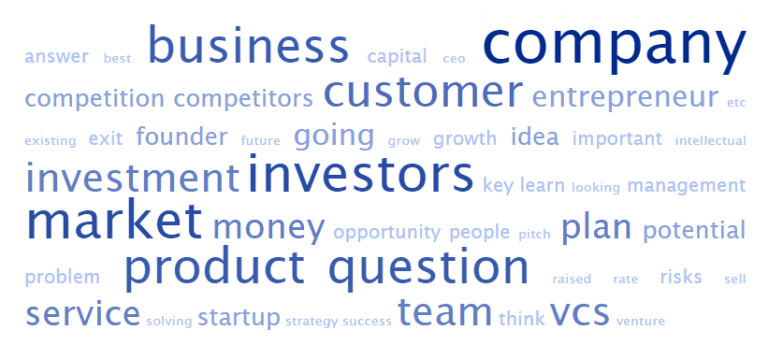There are plenty of resources on the Internet answering – “What are the Questions Investors ask Startups?
So instead of adding one more to the crowd, we decided to analyze the questions and come up with a better answer.
Data Used:
- ~100 selected answers from Quora.
- 20 Medium blog posts by Investors and Founders
- 20 articles on the web (Optimised for keywords, lots of false positive, not included in text analysis)
- We read through 20,000+ words!
Read about : Characteristics Of A Scalable Business
Keyword Analysis:

Top Question types:
- What
- How
- What is
- How do you
- How will you
- How do you plan to
- What are you going to
Top Themes: (in that order)
- Market/Potential/Opportunity/Customer
- Product/Problem/Solution
- Team
- Business/Money/Capital/Sales/Earnings
- Intellectual Property
- Growth/Traction
- Strategy/Plan
- Competitors/Competitive Advantage
Read about : advantages of customer segmentation
Analysis is fine…
Investor meeting is a different ball game. Entrepreneurs need to be thoroughly prepared when meeting an Investor by anticipating the questions they will receive. The failure to have thoughtful and reasonable answers to their questions will decrease the likelihood of the company getting funded.
Entrepreneurs have to impress the investor, be friends with them, and a well thought out plan will help.
How it usually goes:
Investors are normal humans and they want to get to know the entrepreneurs better. At the start of the meeting, there is a usual small talk. Talk about life experiences, interests, current affairs, or tech talk in the media these days. Once the conversation flows they would want to get a clear top-level overview as to what the company does, the market size, why your idea is outstanding and why do you think it may lead to a large exit. It should almost always be a healthy discussion. If it did not turn out that way, chances of a deal are low.
So, in order to help you prepare, outlined below are some questions that investors most frequently ask entrepreneurs. Following each, there is a brief explanation regarding what they might be trying to uncover.


A Qualitative Analysis: Top Questions to Prepare for the Meeting
Depending on What stage you are in and how much you are raising, the questions may change or the discussions may get deep. But the crux remains the same.
Read about: asset utilisation analysis
Market/Potential/Opportunity/Customer
What is the market potential for your company’s product or service offering?
What is the revenue potential for the industry, and what is its growth rate?
How did you calculate market potential? How do you determine industry sales and growth rate?
Why does the market need your product now?
What is the calculated TAM, SAM, SOM?
The investor wants to ascertain if the opportunity is large enough for them to pursue. Typically, an investor will look for a healthy return in a designated timeframe of say 4-7 years. All investors prefer large and growing markets to stagnating ones. Many investors focus on specific sectors, other, sector agnostic investors will consider the market size as major criteria for investment.
Investors typically prefer companies that are trying to be the market leaders in a particular segment. Finally, market potential estimates should be supported by independent research as well as bottom-up or top-down calculations.
Product/Problem/Solution
What problem (or want) are you solving?
What is unique about your product?
Who is the end user of the product or service offering?
Why would someone be “compelled” to purchase your product or service?
Why is it hard to copy?
What have you learned from early versions of the product or service?
Provide a demonstration of the product or service. What are the two or three key features you plan to add? How satisfied are your customers?
What is the vision for the product?
Can you explain some customer use cases?
Investors look for businesses with products or services that address a demonstrable market need or demand. Is your product something the buyer needs? Or is it simply something that would just be nice to have? If it falls into the latter category, then it is critical to demonstrate how your product will gain traction, that is, how people will come to demand it based on market trends
Is this a consumer-based business, or will you sell your product or service to other businesses? What do you know about the demand for your product or service in that target market? What do you know about the buying habits of your target market? Do you anticipate any roadblocks? For example, will you have to educate the buyer? Also, think about how you can leverage partners or resellers to reach your target markets. Knowing the answers to these questions will be critical when you speak to an investor about your opportunity.
Team
Who are the founders and key team members?
Education and past work experience?
Is there a balance between business and technology in the founding team?
Why are you the best team to do this?
What drives you to do this?
How do you plan to scale the team?
What relevant domain experience does the team have?
Investors are typically looking for three things in management: Experience in building a business, experience in the industry (or with the product) and strong character. What comprises the latter? Investors look for managers who demonstrate high energy or passion, resourcefulness, integrity, perseverance, risk-taking ability, and mental horsepower. Also, a frequently overlooked quality is that of humility — for example, sometimes founders may need to step aside and let someone with more experience lead the company.
While the precise conditions of labor markets change, it is always a challenge to find the best people. Investors will not only be interested in the composition of your existing workforce, but also in how you plan to fill key positions now and in the future. Have you used an executive search firm? Do you have qualified candidates currently under review? How will you compensate people, so as attract, motivate and retain employees while keeping labor costs under control?
Business/Money/Capital/Sales/Earnings
How do you plan to make money? Do you have a path to revenue?
Who are you selling to?
How do you know those customers will actually buy your product or service?
How much did you spend on the MVP? How much money are you raising and what is the burn rate?
When will the company break even in terms of profitability and cash flow? What sales have you made so far?
Who else is interested?
What are the company’s five-year projections?
How much equity and debt has the company raised? What is the capitalization structure?
How much of a stock option pool is being set aside for employees?
What is your unit economics?
What are the key metrics that the management team focuses on?
Walk us through leads, sales pipeline, close rate etc. What’s your price point, and what’s your pricing methodology, and why did you settle on both of these?
How do your customers think about ROI on their spend on your product/service?
Investors want to know your monetization model (besides SEO/SEM, ads or passive income streams). they want to know who is/will be paying for your product and at what price point. Tell them about the sales/leads that you have generated. Take money very seriously. When an investor is investing in your startup, they are expecting clear numbers, projections and a hefty return on their investment.
Intellectual Property
Does the company have proprietary intellectual property in the form of patents, trademarks, copyrights, etc.?
Does the company have proprietary Intellectual Property?
What’s proprietary? What are you going to do to defend that?
How strong is your patent? Can the IP be liquidated?
What do you own? What can you protect? These are two critical questions. In some industries (e.g. biotech), patents play a critical role in protecting the research and development investments of the company and in helping to ensure that there is a window of opportunity (usually before competitor offerings arrive) for the company to realize a significant share of revenues for a particular category. Trademarks and copyrights are critical to protecting the company’s intellectual assets and its “brand.” Also, at some point, Investors will also want to ensure that you’ve taken the proper steps (through non-disclosure agreements, non-competes and/or employment agreements) to ensure that the company is protecting its intellectual capital.
Growth/Traction
How do you know that your business has high growth potential?
How do you plan to acquire customers?
How do you plan to keep customers?
How many users do you have?
What are your Customer acquisition cost and customer retention rate?
What is the Customer Lifetime value? How can the early traction be accelerated?
What has been the principal reasons for the early traction?
What is the average churn rate?
What is the daily usage rate?
How many downloads/subscriptions/sign-ups/likes/shares, etc?
A well-developed business plan includes marketing strategies that demonstrate an understanding of market realities and customer behavior. Investors are looking for much more than a list of your marketing initiatives. Do you know how many customers are required to break even? Do you know the product sales cycle?
Once you’ve acquired customers, you’ll need processes to ensure their ongoing satisfaction and your understanding of their changing needs. Have you considered how you’re going to support the product and the expenses associated with such support? Will existing customers purchase your product or service again? Will they recommend it to others? Regular and consistent customer feedback is essential in order to obtain the answers to these types of questions. The most successful companies seem to have a plan for keeping customers even before they acquire them. It is said that it costs five times as much to generate business from new customers as it does from existing customers. Customer retention is critical to the long-term success of most enterprises.
Competitors/Competitive Advantage
Who are your competitors?
Who are your top five competitors and how do you stack up?
Why are you better at solving this problem than your competitors?
What are the key differentiated features of your product or service?
What gives your company a competitive advantage?
What are the barriers to entry?
What is to stop another larger company from doing the same thing?
Compared to your competition, how do you compete with respect to price, features, and performance?
When answering ‘Who are your competitors’, never say ‘No one’. Investors are interested in learning about the extent of competition your business will encounter and how you will distinguish your company. But, they also might be assessing your maturity as a businessperson. The answer “none” is typically incorrect because your business always has competitors. If the investor is aware of competitors that you have not considered (as many have researched particular segments independently), he or she will lose faith in your business assessment skills – so be prepared.
Investors want to know how you plan to outmaneuver the competition – and this doesn’t just pertain to existing competitors. They want to see that you’ve given thought to future market entrants and how you will stave them off. “First-mover advantage” is rarely a sufficient response to this question. A more effective answer usually depicts intellectual property barriers or the ability to reach the target market in a manner that is more effective than the competition.
Strategy/Plan
What are the primary risks facing your business?
What alliances or partnerships have you entered (e.g. joint ventures, marketing alliances, licensing arrangements, selling/distribution agreements, channel partnerships, software agreements, etc.)?
What is the anticipated lifecycle of your product or service offering?
What are your current and future plans for R&D investments?
What are the probable exit scenarios? What are the next steps?
Can you scale up the volume without proportional scaling up headcount?
How are you going to spend investors money?
How does the company market or plan to market its products or services?
What is the company’s PR strategy, Social media strategy?
How will you close deals faster? What do you need from us(besides capital)?
Apart from competition, other risks facing your business could include changes or shifts in technology, governmental and regulatory policies, labor market conditions, business climate changes, product liability, computer crime, etc. And, don’t forget financial risks. It is also important to remember that alliances can be assets and liabilities. Investors will want to know if any of your alliance agreements have comprised your intellectual property claims and if the company has any outstanding obligations to third parties. On the positive side, you’ll want to demonstrate how alliances may have helped your company lock-up certain distribution or sales channels for your products and services. Do any of your alliances give you a competitive advantage? Do they create barriers to entry? Do they help you reach customers more efficiently?
Investors need to know how they’re going to monetize their investment, hopefully at an ROI of 50 percent or more – so the exit strategy is quite important. As an entrepreneur, you should spend some time thinking about who could acquire your business down the road. Investors want to know that their money is being put to good use in order to directly accelerate the business opportunity so that they will receive their ROI in a timely fashion.
Did we miss anything? Do you need help?
Write to us at [email protected]




